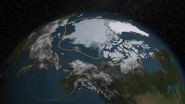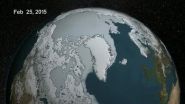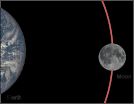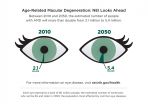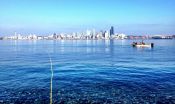(Press-News.org) According to a NASA analysis of satellite data, the 2015 Arctic sea ice minimum extent is the fourth lowest on record since observations from space began.
The analysis by NASA and the NASA-supported National Snow and Ice Data Center (NSIDC) at the University of Colorado at Boulder showed the annual minimum extent was 1.70 million square miles (4.41 million square kilometers) on Sept. 11. This year's minimum is 699,000 square miles (1.81 million square kilometers) lower than the 1981-2010 average.
Arctic sea ice cover, made of frozen seawater that floats on top of the ocean, helps regulate the planet's temperature by reflecting solar energy back to space. The sea ice cap grows and shrinks cyclically with the seasons. Its minimum summertime extent, which occurs at the end of the melt season, has been decreasing since the late 1970s in response to warming temperatures.
In some recent years, low sea-ice minimum extent has been at least in part exacerbated by meteorological factors, but that was not the case this year.
"This year is the fourth lowest, and yet we haven't seen any major weather event or persistent weather pattern in the Arctic this summer that helped push the extent lower as often happens," said Walt Meier, a sea ice scientist with NASA's Goddard Space Flight Center in Greenbelt, Maryland. "It was a bit warmer in some areas than last year, but it was cooler in other places, too."
In contrast, the lowest year on record, 2012, saw a powerful August cyclone that fractured the ice cover, accelerating its decline.
The sea ice decline has accelerated since 1996. The 10 lowest minimum extents in the satellite record have occurred in the last 11 years. The 2014 minimum was 1.94 million square miles (5.03 million square kilometers), the seventh lowest on record. Although the 2015 minimum appears to have been reached, there is a chance that changing winds or late-season melt could reduce the Arctic extent even further in the next few days.
"The ice cover becomes less and less resilient, and it doesn't take as much to melt it as it used to," Meier said. "The sea ice cap, which used to be a solid sheet of ice, now is fragmented into smaller floes that are more exposed to warm ocean waters. In the past, Arctic sea ice was like a fortress. The ocean could only attack it from the sides. Now it's like the invaders have tunneled in from underneath and the ice pack melts from within."
Some analyses have hinted the Arctic's multiyear sea ice, the oldest and thickest ice that survives the summer melt season, appeared to have recuperated partially after the 2012 record low. But according to Joey Comiso, a sea ice scientist at Goddard, the recovery flattened last winter and will likely reverse after this melt season.
"The thicker ice will likely continue to decline," Comiso said. "There might be some recoveries during some years, especially when the winter is unusually cold, but it is expected to go down again because the surface temperature in the region continues to increase."
This year, the Arctic sea ice cover experienced relatively slow rates of melt in June, which is the month the Arctic receives the most solar energy. However, the rate of ice loss picked up during July, when the sun is still strong. Faster than normal ice loss rates continued through August, a transition month when ice loss typically begins to slow. A big "hole" appeared in August in the ice pack in the Beaufort and Chukchi seas, north of Alaska, when thinner seasonal ice surrounded by thicker, older ice melted. The huge opening allowed for the ocean to absorb more solar energy, accelerating the melt.
It's unclear whether this year's strong El Niño event, which is a naturally occurring phenomenon that typically occurs every two to seven years where the surface water of the eastern equatorial Pacific Ocean warms, has had any impact on the Arctic sea ice minimum extent.
"Historically, the Arctic had a thicker, more rigid sea ice that covered more of the Arctic basin, so it was difficult to tell whether El Niño had any effect on it," said Richard Cullather, a climate modeler at Goddard. "Although we haven't been able to detect a strong El Niño impact on Arctic sea ice yet, now that the ice is thinner and more mobile, we should begin to see a larger response to atmospheric events from lower latitudes."
In comparison, research has found a strong link between El Niño and the behavior of the sea ice cover around Antarctica. El Niño causes higher sea level pressure, warmer air temperature and warmer sea surface temperature in west Antarctica that affect sea ice distribution. This could explain why this year the growth of the Antarctic sea ice cover, which currently is headed toward its yearly maximum extent and was at much higher than normal levels throughout much of the first half of 2015, dipped below normal levels in mid-August.
Starting next week, NASA's Operation IceBridge, an airborne survey of polar ice, will be carrying science flights over sea ice in the Arctic, to help validate satellite readings and provide insight into the impact of the summer melt season on land and sea ice.
INFORMATION:
NASA uses the vantage point of space to increase our understanding of our home planet, improve lives, and safeguard our future. NASA develops new ways to observe and study Earth's interconnected natural systems with long-term data records. The agency freely shares this unique knowledge and works with institutions around the world to gain new insights into how our planet is changing.
For more information about NASA's Earth science activities, visit:
http://www.nasa.gov/earth
Earth's gravity has influenced the orientation of thousands of faults that form in the lunar surface as the moon shrinks, according to new results from NASA's Lunar Reconnaissance Orbiter (LRO) spacecraft.
In August, 2010, researchers using images from LRO's Narrow Angle Camera (NAC) reported the discovery of 14 cliffs known as "lobate scarps" on the moon's surface, in addition to about 70 previously known from the limited high-resolution Apollo Panoramic Camera photographs. Due largely to their random distribution across the surface, the science team concluded that the ...
People with a genetic predisposition for age-related macular degeneration (AMD) significantly increased their odds of developing the blinding eye disorder if they had a history of heavy smoking and consistently did not exercise or eat enough fruits and vegetables, according to an observational study of women funded by the National Eye Institute, part of the National Institutes of Health.
Eating a healthy diet and getting exercise have been shown in earlier studies to protect against AMD, a leading cause of vision loss among people age 50 and older. Findings from this ...
A new computational model developed by scientists from the University of Chicago could help improve the allocation of U.S. biomedical research resources. The tool, called the Research Opportunity Index (ROI), measures disparities between resources dedicated to a disease and its relative burden on society. ROI identifies diseases that receive a disproportionate share of biomedical resources, which represent opportunities for high-impact investment or for the realignment of existing resources. It is designed to provide an unbiased, data-driven framework to help scientific ...
In the midst of ferry boats, container ships and tourists crowding Seattle's Elliott Bay, young salmon are just trying to get a decent meal.
The fish hatch in the rivers and streams that feed into Puget Sound and almost immediately rely on eating small organisms near the shore, including in the heart of Seattle's commerce-filled waterfront.
Though salmon share the busy Elliott Bay waters with boats and barges, scientists suspect built-up, "armored" shorelines and large piers may be the main culprits disrupting fish habitat. These artificial structures block light and ...
Reminders to take medication, delivered to patients via an electronic pillbox, may be able to improve adherence to tuberculosis (TB) treatment. The findings, reported this week in PLOS Medicine, are the result of a cluster randomized controlled trial by Shiwen Jiang of the Chinese Centers for Disease Control & Prevention, Katherine Fielding, of the London School of Hygiene & Tropical Medicine, and colleagues.
The study randomized 36 districts in the provinces of Heilongjiang, Jiangsu, Hunan, and Chongqing, China to receive one of four approaches to tuberculosis case management: ...
Selective serotonin reuptake inhibitor (SSRI) use is modestly associated with violent crime, according to a study published this week in PLOS Medicine. The cohort study, by Seena Fazel from the University of Oxford, and colleagues, showed in subgroup analysis that this association was evident in participants aged 15-24, but not significant for individuals aged 25 and older.
SSRIs are widely prescribed, but inconclusive evidence links SSRI use with violent behavior. In this study, Fazel and colleagues compared the rate of violent crime while individuals were prescribed ...
Giving electronic reminders to tuberculosis (TB) patients in China can reduce the amount of medication doses they miss by half, according to new research published in PLOS Medicine.
Researchers from the London School of Hygiene & Tropical Medicine, UK, and the National Center for Tuberculosis Control and Prevention, China, conducted a trial with 4,173 patients from the provinces of Heilongjiang, Jiangsu, Hunan, and Chongqing. Patients either received text message reminders, an electronic medication monitor, both, or no reminders for their six month treatment period.
Patients ...
Measuring how religion affects a person's political attitudes and behavior can provide powerful insight to everyone from pundits to presidents.
Now there's a new strategy to gather better, more nuanced perspective on that religious influence than ever before, developed by University of Cincinnati researchers.
UC's Andrew Lewis and Stephen Mockabee presented research titled "Measuring Biblical Interpretation and Its Influence on Political Attitudes" at the American Political Science Association's annual meeting earlier this month in San Francisco. The association serves ...
MEDFORD/SOMERVILLE, Mass. (Sept. 15, 2015) -- Regenerative medicine using stem cells is an increasingly promising approach to treat many types of injury. Transplanted stem cells can differentiate into just about any other kind of cell, including neurons to potentially reconnect a severed spinal cord and repair paralysis.
A variety of agents have been shown to induce transplanted stem cells to differentiate into neurons. Tufts University biomedical engineers recently published the first report of a promising new way to induce human mesenchymal stem cells (or hMSCs, which ...
A quarter of a century ago, the physicist, physician and cell biologist Professor Thomas Jentsch and his research team opened up an entirely new field of research in the field of ion transport. Now the British journal "The Journal of Physiology"* has devoted a special section in its latest issue to his discovery. In this issue (DOI: 10.1113/jphysiol.2014.270043), Professor Jentsch, who leads a research group at the Max Delbrück Center for Molecular Medicine in the Helmholtz Association (MDC) and at the neighboring Leibniz-Institut für Molekulare Pharmakologie ...
